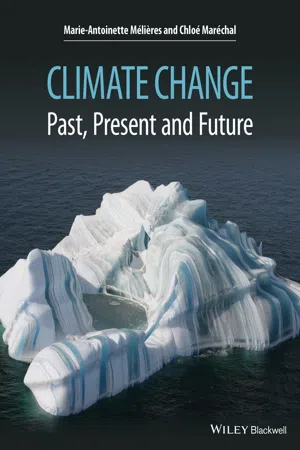
- English
- ePUB (mobile friendly)
- Available on iOS & Android
About This Book
This book is designed for first- and second-year university students (and their instructors) in earth science, environmental science, and physical geography degree programmes worldwide. The summaries at the end of each section constitute essential reading for policy makers and planners. It provides a simple but masterly account, with a minimum of equations, of how the Earth's climate system works, of the physical processes that have given rise to the long sequence of glacial and interglacial periods of the Quaternary, and that will continue to cause the climate to evolve. Its straightforward and elegant description, with an abundance of well chosen illustrations, focuses on different time scales, and includes the most recent research in climate science by the United Nations Intergovernmental Panel on Climate Change (IPCC). It shows how it is human behaviour that will determine whether or not the present century is a turning point to a new climate, unprecedented on Earth in the last several million years.
Frequently asked questions
Information
PART I
THE CLIMATE ENGINE OF THE EARTH: ENERGY
Chapter 1
Why are there many different climates on Earth?
- First, we enquire into the source of energy that continuously supplies the Earth’s surface and sets the operating range of temperature. This is the Sun alone, all the other sources of energy being incomparably weaker. The flow of energy is defined primarily by the Sun’s radiation and is a function of its activity. The amount of solar energy received on the Earth also depends on the distance between the Earth and the Sun. The position of the Earth in the solar system is thus the first key factor that, unlike our neighbouring planets, enables it to host life in abundance.
- The second characteristic of planet Earth is its atmosphere, which by its composition modifies the flow of energy arriving at the surface. The greenhouse gases (GHGs) in our atmosphere play a leading role in this flow, increasing the energy available at the surface of the planet and raising its average temperature.
- Since the Earth is practically spherical, the solar flux falling on its surface is spread very unevenly over the different latitudes. At higher latitudes, the Sun’s rays become increasingly tilted with respect to the surface and, on moving from the Equator to the poles, less and less energy is received per square metre (Part I, Note 1). This property defines the first major characteristic of climates on Earth: temperature decreases from the Equator to the polar regions.
- The temperature difference between the Equator and the poles is nonetheless attenuated by the universal principle that heat propagates from hot regions to cold regions. Heat is transferred from the tropics towards higher latitudes by three transport mechanisms: atmospheric circulation, ocean circulation and the water cycle.
- Owing to the tilt of the axis of rotation of the Earth in the ecliptic (the plane in which the Earth moves around the Sun during the year), the slope of the Sun’s rays, and hence the energy delivered to each point on the Earth, oscillates throughout the year. This gives rise to the different seasons, as described in Box 1.1.
- Finally, since the orbit of the Earth around the Sun is slightly elliptical rather than perfectly circular, the Earth–Sun distance varies over the course of the year. This is accompanied by variations in the amount of energy received during the year, but these variations are much smaller than those that give rise to the seasons. Over thousands of years, however, their slow changes have a major impact.
BOX 1.1 THE SEASONS

Table of contents
- Cover
- Title page
- Copyright
- Foreword
- Acknowledgements
- About the companion website
- Introduction
- PART I: THE CLIMATE ENGINE OF THE EARTH: ENERGY
- PART II: MORE ON THE ENERGY BALANCE OF THE PLANET
- PART III: THE DIFFERENT CAUSES OF CLIMATE CHANGE
- PART IV: LEARNING FROM THE PAST …
- PART V: CLIMATE CHANGE IN RECENT YEARS
- PART VI: CLIMATE IN THE 21ST CENTURY: DIFFERENT SCENARIOS
- Conclusion
- References
- Index
- End User License Agreement